
By Stephen Marsar
Hurricanes Harvey, Irma, and Maria, the destructive and deadly Category 3 and 4 hurricanes that pounded the United States this year, were so destructive that the World Meteorological Organization may vote to retire their names. Between August and October 2017, these three storms battered the Gulf Coast, Texas, Florida, and Puerto Rico, setting off some of the largest federal emergency responses in U.S. history. Before the first of these storms made landfall, the wheels were set in motion for an unprecedented response. The Fire Department of New York (FDNY) was requested to take part in a national response that included incident management teams (IMTs), urban search and rescue (US&R) teams, the U.S. military, the Red Cross, and volunteers from throughout the country.
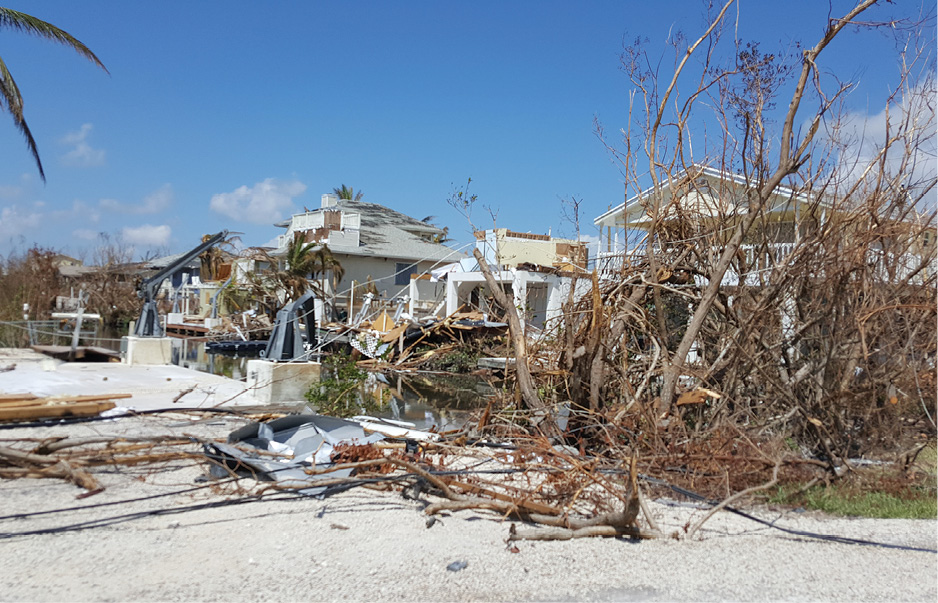
(1) Damaged homes in Big Pine Key, Florida. (Photos courtesy of the FDNY IMT public information officer. )
Hurricane Harvey, Texas
Making landfall near Rockport, Texas, on August 25, 2017, this Category 4 hurricane dropped an estimated 53 inches of rain over a four-day period. With sustained winds of more than 120 miles per hour (mph), the storm inundated the southern counties of the state, flooding hundreds of thousands of homes, displacing tens of thousands of people, and necessitating more than 17,000 rescues (photos 3-5).

(2) The site of the Houston NRG Stadium.
On August 27, the Texas A&M Forest Service (Forest Service) requested assistance from the FDNY IMT. The formal state-to-state Emergency Management Assistance Compact (EMAC) request was later absorbed into a much larger federal order. Following the guidelines established under the Robert T. Stafford Disaster Relief and Emergency Assistance Act of 1988, Texas Governor Greg Abbott made a state disaster request, and President Donald Trump approved a subsequent Federal Disaster Declaration. Under the federal declaration, the FDNY IMT managed a resource staging area (RSA) that accommodated more than 1,000 Federal Emergency Management Agency (FEMA) tractor trailers of water, ice, meals ready to eat (MREs), and other commodities that would arrive in Texas. The team’s challenge was to accept delivery, organize, stage, and distribute those resources, as needed, to county staging areas and points of distribution throughout southern Texas. These tasks were outlined in the “Lone Star State Commodity Distribution Plan.” Particularly, the area of focus for these staging areas comprised the southern counties of Harris and Jefferson and the city of Houston. The 14-day commitment included 24-hour operations. The mission included providing three meals a day, shower facilities, and support for the truckers and their vehicles.

(3-5) Flooding conditions in Eldridge, Texas, just outside the Academy incident command post.
Shortly after receipt of the request, team members were notified to immediately update their availability for possible deployment. Simultaneously, the FDNY IMT’s Command and General Staff (C & G) met to perform a needs assessment and to organize and deploy a 12-member “advance team.” Two days later, that team was in College Station, Texas, and established the team’s objectives. The advance team received an initial briefing from the Forest Service and, after assessing conditions and the demands of the assignment, the C & G examined and approved a Delegation of Authority, which included the scope of practice, mission objectives, benchmarks, and the management hierarchy, strictly following National Incident Management System and Incident Command System standards and guidelines.
The FDNY IMT established incident objectives and initiated a plan to position a 65-member IMT just outside the flooded areas in Harris County. The team members at home in New York awaited their deployment instructions. The deployment order arrived on the afternoon of August 27, and on August 28, the members departed on five commercial flights from four New York-area airports. The team mustered at the Dallas/Fort Worth Airport and convoyed on a four-hour ride to College Station. Three rented pickup trucks, a box truck, and four mini vans transported the team, its gear, and basic supplies.
While this movement was underway, an additional 12-member FDNY IMT equipment cache contingent was making the 1,600-mile journey from New York City (NYC) to Texas with the team’s full complement of supplies and equipment.
The IMT met their colleagues from the Advance Team on August 29 in College Station. The C & G staff conducted an initial team briefing, laying out their understanding of the team’s possible missions and the plan to move out to the point of operation the following morning. Following that briefing, the C & G staff left for a briefing with Paul Hannemann, the Forest Service administrator. The following morning, the FDNY IMT packed its belongings, met for a brief team meeting, conducted a Roll Call [personnel accountability report (PAR)], and headed south toward Houston.
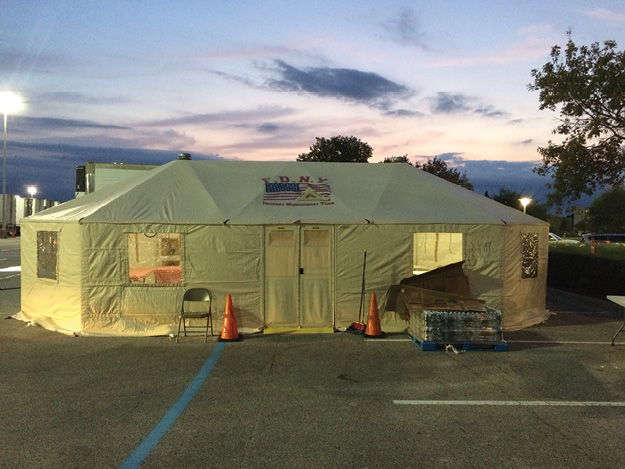
(6) FDNY IMT’s resource staging area at the Houston NRG stadium.
The IMT was directed to the Academy Sports and Outdoor Sporting Goods headquarters in Katy, Texas. This company generously donated its operations and distribution complex to assist in the rescue and recovery efforts. In just a couple of hours, and before the hurricane had fully dissipated, the Academy complex was transformed into the incident command post (ICP) and one of the two RSAs ultimately established. The next day, a second RSA was established at the Houston NRG Stadium (photo 6). In addition, a temporary tractor trailer storage depot was set up at the Katy Mills mall to accommodate tractor trailer overflow; that lot was donated by the owners and coordinated through the general manager, Don Massey.
Seamless Integration
Under Unified Command, the 65-member FDNY IMT integrated operations with 20 members of the Lone Star Type 1 IMT at the Academy and NRG locations under the auspices of the Forest Service, commanded by Steven Pollack, incident commander (IC). Additionally, the FDNY IMT was supported by a wildland firefighting hand crew from the Kentucky Division of Forestry, which staffed and assisted operations at the NRG RSA, and a camp crew from the Frenchburg (VA) Job Corps, who kept the ICP and operations at the Academy RSA running smoothly 24 hours a day. Together, on their Federal Resource Order, these two crews were officially known as “Harvey 1.”
The friendly and professional relationship that allowed the seamless integration of the Lone Star and FDNY IMTs was forged back in December 2013. At that time, 55 members of the Lone Star IMT arrived in NYC after the destructive Superstorm Sandy. The Lone Star Team was the only IMT to relieve the FDNY (for a 14-day period) during what turned out to be a four-month deployment for the FDNY, during the cold, winter holiday season. Hurricane Harvey was the opportunity for the FDNY IMT to pay back their Lone Star counterparts.
Critical Mission
On Thursday, August 31, just as the FDNY IMT arrived in Houston to claim their luggage and settle in after concluding the first full day of FDNY operations (of the 24-hour operational period), the Forest Service team identified a “critical needs” situation that the C & G had to attend to immediately. Approximately 9,000 people stranded in Beaumont, Texas, were running dangerously low on food, water, and ice. These residents had sustained themselves for almost six days after the flood waters virtually sealed them off from the mainland.
Keeping within the structure of Unified Command and in conjunction with the U.S. Army (using Chinook helicopters and flying approximately 10 sorties), Texas National Guard personnel and the Texas State Police, which provided security; the over-the-road truck drivers contracted by FEMA; and the FDNY IMT delivered more than 30 tractor trailers of water, ice, MREs, and human necessities to the Beaumont residents. The supplies were stored at the Academy parking lot, which was used as a temporary emergency landing zone. Over the next week, an additional 20 tractor trailers of supplies were sent to Beaumont by air, boat, and eventually over the roads in convoys escorted by the Texas State Police (photo 7).
On average, the FDNY IMT Texas deployment saw approximately 80 tractor trailers a day shipped out from the Academy and NRG RSAs with an even greater number being checked in per day. Ultimately, the joint operation of the FDNY and Lone Star IMT managed two RSAs from which more than 500 tractor trailers a day delivered eight million pounds of ice, one million gallons of water, and three million MREs. An additional 12 tractor trailers delivered cots and human necessities.

(7) Texas State Police escorts a convoy of supplies to Beaumont, Texas.
Deployments aren’t always what we’d like them to be. Although most members of the FDNY IMT wanted to be directly involved with the rescue efforts and the possibility of managing national US&R task forces in the initial stages of Hurricane Harvey’s aftermath, the disappointments were quickly overcome with a challenging logistical assignment that provided much-needed supplies and life-sustaining support to the civilians most severely affected by this devastating hurricane and flooding.
That challenge was accepted, overcome, and successfully concluded. In the end, members took satisfaction in a job well done. However, the celebration had to be put on hold.
Hurricane Irma, Florida
As the FDNY began the demobilization process and the transition of operations in the Houston area to the Forest Service and the Lone Star IMT, Hurricane Irma had become a threat to the state of Florida. On September 11, the remnants of Hurricane Irma swept through Florida. The accompanying winds tore down trees and power lines, leaving behind a trail of debris, flooding, and power outages that ultimately affected most of the state at one point or another. As the FDNY IMT members deployed in Texas were heading back to NYC, a second full contingent of team members was being sent to Florida. These teams were in addition to a third team in NYC that was prepared to respond to any large-scale incidents that may occur there.
Leaving Texas and heading back east, the FDNY IMT equipment cache drivers stayed along a southern state’s route in anticipation of being detoured to Florida. Ultimately, we received a FEMA order to stage the equipment cache in Atlanta, Georgia. The FDNY IMT and cache checked into the FEMA staging area at Moody Air Force Base on the Florida/Georgia line. There, they awaited orders to deploy and to rendezvous with the remainder of the IMT flying down from New York.
As part of the National Response Framework, the FDNY IMT received an Emergency Support Function 4 (ESF-4) request and was asked to oversee the establishment of an incident responder camp capable of housing 1,000 personnel in Homestead, Florida.
Note: When the federal government, through FEMA, requests an asset, that asset gets assigned through the corresponding ESF desk for processing, reporting, and oversight. This means that the federal system oversees the IMT and defines the team’s mission; it also defines the cost limitations and is the clearing house for orders of personnel, equipment, and supplies. The FDNY IMT, on the other hand, must keep the federal government (through the ESF) apprised of the team’s progress, successes, and future plans. In addition, the FDNY IMT needs to provide daily status reports and cost-containment measures, both implemented and planned. In these cases, the FDNY IMT works for the federal government, providing services to the states.
Creating a Home in Homestead
Homestead is just north of the Florida Keys and was identified as an acceptable location for a camp for emergency response personnel and utility repair crews, who would be assisting with restoration and recovery in the Keys.
The FDNY IMT arrived in Florida on September 12. Since Florida was still formulating and organizing its response and post-storm efforts, the FDNY IMT was originally deployed to Jacksonville, Florida; redirected to the Ft. Meyers/Coral Gables area; and then redirected once more to Homestead, where the group had access to its equipment cache and where the remainder of its team members were staged.
At this time, the cache driving team—which had driven 1,600 miles from New York to Texas; worked for six days in the sweltering parking lot of the NRG RSA in Houston, Texas; and then drove back to Florida—was demobilized for rest and recuperation. A fresh crew replaced them.
Establishing the camp at Homestead enabled response and utility crews to vacate the hotels they were occupying in the Keys, making those rooms available for returning residents whose homes were uninhabitable. The FDNY IMT oversaw the design, planning, and construction of the camp by private contractors. The team had to ensure that the camp would be safe, secure, and suitable for the emergency crews working under the direction of the State of Florida.
Camp Big Pine Key
While the Homestead camp tasks were being completed, the FDNY IMT was asked to establish an additional camp that would house more than 500 additional responders in Big Pine Key. Big Pine Key and the Keys to its south were extremely impacted by storm damage, necessitating yet another base of operations for responders and utility crews. The FDNY IMT assumed this additional responsibility. At the end of its 14-day assignment in Florida, the team transitioned responsibilities of the Homestead camp to the Maryland State IMT and the Big Pine Key camp to the Baltimore City IMT. During this transition, on September 20, Hurricane Maria struck and devastated Puerto Rico and the Caribbean Islands.
Florida Conclusion
The damage Hurricane Irma caused in Florida—as bad as it was—luckily was not as devastating as was first predicted. In view of the robust state planning and trained resources available and the state’s experienced response and recovery programs already in place, the FDNY IMT was released, given two days off, and made available for a Hurricane Maria response.
Hurricane Maria, Puerto Rico
Six days after Hurricane Maria’s landfall, FEMA sent an ESF-4 request to the FDNY IMT to deploy to Puerto Rico. On Tuesday, September 26, the FDNY IMT arrived in Puerto Rico. The team’s mission was to support the Puerto Rico Fire Department (PRFD) in the wake of the hurricane. The FDNY IMT’s C & G staff were greeted at the airport by Puerto Rico’s Governor Ricardo Rosello and the PRFD Chief of Department Alberto Cruz.
PRFD Lieutenant Joel Figueroa held an agency administrator briefing at which he explained the objectives for the FDNY IMT. The primary objective was to assess and, if possible, repair or restore the PRFD’s communication system. Immediately, the FDNY IMT formed an Interagency Communication Task Force (TF) consisting of a communication leader, communications technicians, communication specialists, and a radio operator from the FDNY Communications Bureau. The TF was to be deployed across the island to canvass and inspect all critical radio infrastructures. To successfully meet their objectives, the Communication TF established working relationships and cooperated with multiple U.S. Department of Defense entities and federal agencies.
Assessment of PRFD Firehouses
Additional objectives for the FDNY IMT included conducting PRFD firehouse assessments to determine needs associated with structural integrity, living conditions, equipment, apparatus, fuel, hydrants, water sources, and staffing (photos 8-10).
Note: Back in NYC, Chief of Department James Leonard and Chief of Operations John Sudnik sent out a call to all FDNY fire and EMS personnel for volunteers to respond to Puerto Rico in anticipation of the need to staff or support the PRFD. More than 800 fire officers and firefighters and more than 350 EMS officers and emergency medical technicians were willing to travel and support the PRFD and the residents of Puerto Rico (just as the FDNY did for New Orleans in the aftermath of Hurricane Katrina in 2005).
As the FDNY IMT assessed each of the PRFD’s 95 firehouses, the team followed up with daily reports and detailed lists of needs discovered and then worked with the local, state, and federal resources to fulfill those needs. In addition, the FDNY IMT distributed water, ice, MREs, and hospitality kits to the on-duty firefighters so that they could continue to provide fire and rescue operations throughout the island.
Situation Reports
The October 1 FDNY IMT Situation Report included the following: “… Today’s operations will continue firehouse assessments, concentrating on the western portions of the island. Teams will assess firehouses in the Arecibo, Aguadila, Mayaguez, and Ponce districts. To date, assessments have been completed in 76 of the 95 firehouses. The Communications TF will continue inspecting apparatus radios, portable radios, station radios, and radio tower sites for a status check of the related equipment. The FDNY IMT will continue to coordinate fulfillment of immediate needs through FEMA and the EOC in the San Juan Convention Center.”
Just two days later, the Situation Report included, “… initial assessment of all PRFD firehouses, with the exception of the Vieques and Culbera Island facilities (which will be visited tomorrow), has been completed. The Interagency Communications TF restored five federal repeaters, enabling additional frequencies to become available and operational once again. The restoration of these frequencies will increase island-wide the communications for federal response agencies. These frequencies will serve as a safety net for responders while the PRFD communications continue to be restored.”
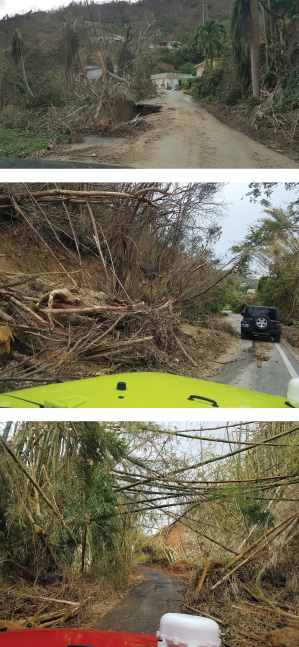
(8-10) The FDNY IMT’s Firehouse Assessment Task Force fights through Hurricane Maria’s aftermath to survey PRFD stations.
The report of October 3 concluded that the operations for that period entailed a more comprehensive look at the fire operation capabilities of the PRFD including hydrant serviceability, water tanker shuttles, and drafting operations. The report pointed out that with PRFD members working twice the number of hours a week than normal, the Firehouse Assessment TF will focus on whether FDNY needs to supply supplemental staffing to relieve PRFD members.
Note: The PRFD firefighters continually arrived for their shifts even though some had suffered losses from the storm in their private lives. On arrival of the FDNY IMT Firehouse Support TF at every facility, the PRFD firefighters were there and ready to operate. In some cases, that readiness was despite the absence of running/potable water, electricity, or communications.
Needs Assessment Inspections Completed
On October 5, in addition to the continued surveying and assessing of each PRFD fire station, the FDNY Interagency Communications TF visited the island of St. Croix to repair infrastructure that affected the PRFD’s communications on the east side of Puerto Rico. During the remainder of that operational period, the TF concentrated on the PRFD’s Central Region.
On October 7, the final day of comprehensive fire station assessments and one of the largest single-day assessment completions (26 firehouses), the critical needs of the PRFD were now fully realized, documented, and compiled. This day also saw the FDNY securing water, ice, and MREs for large-scale distribution to the entire PRFD and the Interagency Communications TF’s success in powering up PRFD communication abilities to a large portion of the island, except for the southern areas, which suffered complete infrastructure failure, antenna towers being completely blown down or snapped in pieces by Hurricane Maria’s 130-mph winds (photos 11-13).
At the end of this day, the FDNY IMT C & G staff met with the PRFD senior leadership and presented the critical needs assessment and the steps being taken to address those issues. The FDNY IMT leadership was also able to outline the procedures for the PRFD to apply for preparedness and recovery grants from FEMA.
The FDNY now established a Diesel Repair TF to repair out-of-service PRFD facility generators. This TF was comprised of FDNY members and the New Jersey State National Guard’s 44th Infantry Brigade—Combat Team. Meanwhile, the Firehouse Support TF began to revisit PRFD firehouses to monitor conditions and the progress of previously identified repairs.
Because of the PRFD extended working shifts and lack of connectivity and electricity, many PRFD firefighters throughout the island had not yet received information on the damage claims process. The FDNY Firehouse Support TF also began distributing FEMA Recovery packets to PRFD members with instructions for filing claims for their personal losses.
The FDNY IMT Interagency Communications TF also kept focusing on temporary patches to the PRFD communications infrastructure along the island’s southern regions to complete an islandwide communications network.
Road clearing became more abundant from October 8-10; the FDNY substantially increased the deliveries of MREs, water, and ice to the PRFD firehouses and the people of Puerto Rico members encountered along the newly accessed distribution routes (photo 14). The Interagency Communications TF continued with infrastructure repairs.
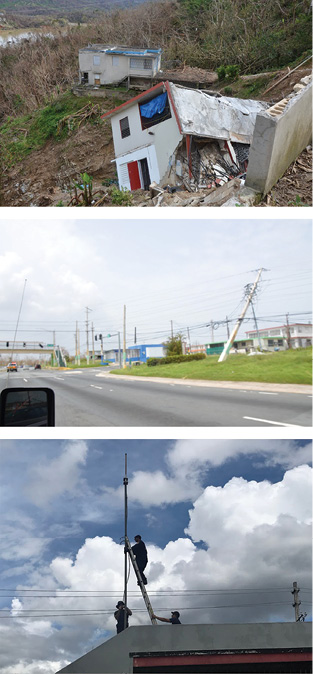
(11-13) The FDNY Interagency Communications Task Force repaired damages to the PRFD communication system.
Taking lessons learned from New York in the aftermath of September 11, 2001, and Superstorm Sandy in 2013, the FDNY IMT C & G staff facilitated the establishment of a dedicated desk at the FEMA headquarters in the Puerto Rico Convention Center exclusively for PRFD members to file claims for the damages to their homes.
Eight days after the storm made landfall in Puerto Rico, the PRFD leadership reinstituted its regularly scheduled work shifts. This decision gave the PRFD members much deserved time off.
Transfer of Command and Transition
All the PRFD data collected by the FDNY Firehouse Support, Communications, and Diesel Generator TFs had to be documented not only for the PRFD leadership but also in a comprehensive and detailed report to the FEMA ESF-4. The FDNY IMT’s C & G staff met regularly with the PRFD leadership and FEMA ESF-4 representatives. These meetings included the related best practices and firsthand experience of the IMT in dealing with FEMA during the recovery and preparedness stages of emergency management.
During their deployment, the FDNY IMT TFs specifically looked at PRFD infrastructure, communications, living/working/sanitary conditions, staffing, fatigue, stress-related signs and symptoms, equipment, apparatus, fuel accessibility, generators, hydrant systems, and water sources. The FDNY IMT was fortunate to have worked with many other agencies and the New Jersey State National Guard to accomplish their assigned tasks.
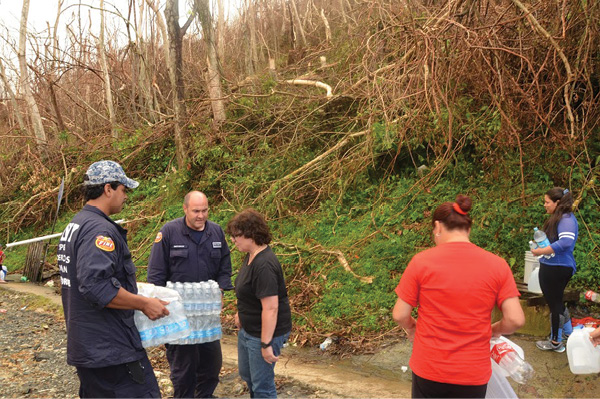
(14) FDNY and PRFD members delivered MREs, water, and ice to PRFD firehouses and to the people of Puerto Rico they met along the improving access routes.
On October 11, the FDNY IMT members paused from their daily operations to observe moments of silence to coincide with the FDNY Annual Memorial Day service underway in NYC to recognize all the members of the FDNY who died in the previous year including EMT Yadira Arroyo and Firefighter William Tolley, who died in the line of duty, and 10 other firefighters who died not in the line of duty. On conclusion of this service, the FDNY IMT members completed the transition of the incident to the PRFD and FEMA ESF-4.
The hard work, dedication, self-sacrifice, and steadfast commitment of the PRFD’s leadership and firefighters are values that will enable the department to continue to serve the citizens of Puerto Rico, to grow in their abilities and skills, and to ultimately recover from this devastating natural disaster.
“Mantente seguro y buena suerte”—Stay safe and good luck!
Stephen Marsar, MA, EFO, is a 28-year veteran of the Fire Department of New York (FDNY), where he is a battalion chief in Operations. He is a former chief and commissioner of the Bellmore (NY) Volunteer Fire Department. His certifications include National Incident Safety Officer, FDNY IMT-Type 1 Unit Leader, National and N.Y. State fire instructor level II, Department of Health regional faculty member, and certified instructor coordinator. An adjunct professor at the Nassau Community College, Long Island, NY, he also serves as a chief instructor for the FDNY, Nassau County Fire Service and EMS academies. He has a master’s degree in homeland security and defense from the Naval Post Graduate School, Monterey, CA, and a bachelor’s degree in fire science and emergency services administration from Empire State College. Marsar is a graduate, with honors, of the National Fire Academy Executive Fire Officer Program, a Roll of Honor inductee, and a two-time winner of FEMA’s National Outstanding Research Award. He writes the Company Officer Development column for FireRescue magazine and is an advisory board member of Fire Engineering.

